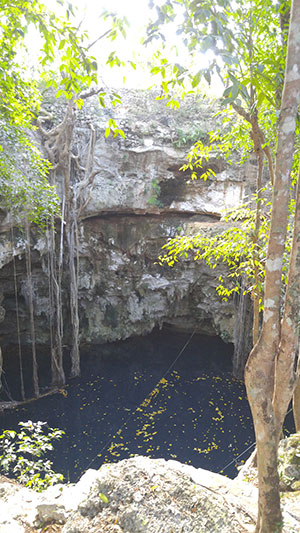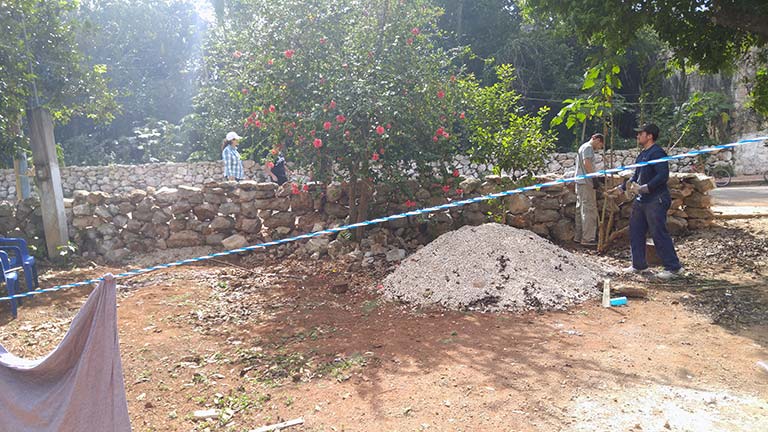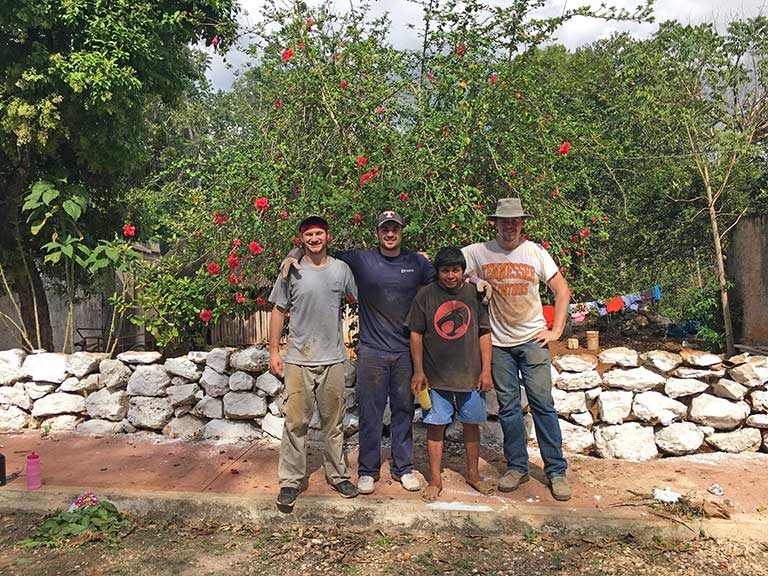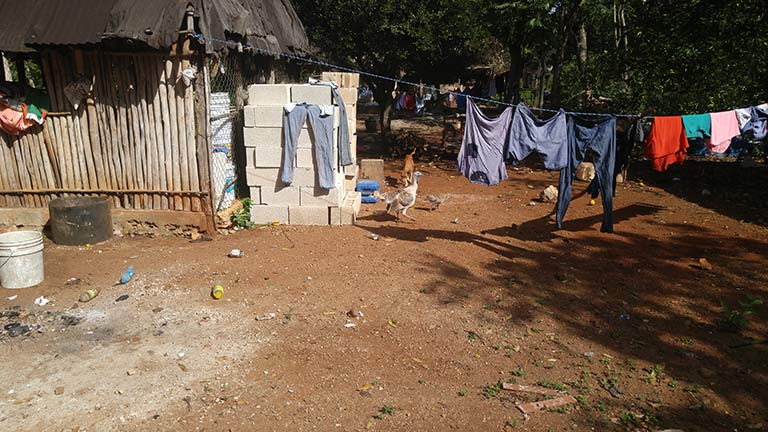Grayson Jones: Student Report from 2016 Alternative Winter Break in Mexico
Facts, History, and Impressions

The Yucatán peninsula is a cultural center for the Mayan people. The indigenous tribe populated the area, with settlements dating as far back as 1800 BCE, in what has become modern day Mexico, Guatemala, Belize, Honduras, and El Salvador. The Yucatán peninsula is on a foundation of limestone, a very porous rock. The nature of this type of bedrock means that the majority of the rivers and fresh water in the area are underground. Consequently, water was very scarce in the area, particularly since it’s a tropical area, so it only experiences a wet and dry season. The Mayans relied on massive sinkholes, colloquially known as cenotes, to provide access to the fresh underground river water, and deep hand-dug pits called cisterns to collect rainwater for the dry season. While no one is sure exactly why the Mayans almost entirely disappeared from the area around 800 CE, the leading expert theory is that the burgeoning population overused the land and, when compounded with a several years’ long drought, the resulting famine caused a fall into chaos of the city-states’ societal structures. However, some city-states, such as Chichén Itzá, Uxmal, and Mayapan, survived the extinction and flourished until the arrival of the Spanish Conquistadors in the 1500s. During the Spanish Invasion, much of the Mayan culture was destroyed—books were burned, the religion was suppressed and eradicated, the people were killed or taken into slavery because the Spanish were bringing Christianity and civility to the “savages” of the new world.
Currently there are several languages that are part of the Mayan language family, which is collectively spoken by over 7,000,000 people (as a first language for many of them, at that). These native Mayan speakers, the legends that have been passed down orally, and the ruins of the old civilization are all that’s left of the Mayan people. Unfortunately, the Mayans used hieroglyphics to write, all understanding of which was lost in the Spanish conquering (the modern Mayan language was recorded in the Latin alphabet only 300 years ago). This loss of cultural artifacts, as well as the wealth of yet undiscovered cities hidden beneath the jungle or beneath the foundations of modern cities and villages, makes the region a prime site for archaeological digs. The village of Yaxuna in the central region of the peninsula is an excellent example of one of these untapped cultural sites. A village of subsistence farmers, littered with abandoned houses and buildings as many of the locals endeavor to find work in the cities as the tourism economy blossoms, and home to one of the larger and better-preserved cenotes of the area, Yaxuna is in an unfortunate state of disrepair. We assisted alongside a group of high school students from Northern Mexico on attempting to reconstruct and beautify the area so as to attract more archaeologists and tourists. Parts of our group worked on clearing some of the invasive foliage, while others worked on rebuilding the walls that surround the properties—walls made of large stones stacked in a particular fashion so that they stand without the use of mortar or any other bonding agents. The Mexican students worked on painting the buildings and walls, as well as assisting in the clearing and construction/deconstruction. The time I spent chatting with the local man whose house we were building a wall for is something I won’t ever forget. Hearing how strikingly different his life has been, and still is, from mine as his daughter blasts an Ariana Grande song in their house and I recognize I’m really not that far from home was a chilling experience. It certainly helped put my situation in the world, or at least in North America, into perspective.

Reflections
I have not had many opportunities to travel in my life so far, and if there’s any single fact of my life I’d like to invalidate after my trip this past winter with the Tickle College of Engineering, it’s that one! When I arrived in the Cancun airport and met our coordinator Judith Mallory, and our tour guide Ana Maria, as well as a few soon-to-be friends from various engineering disciplines along with a couple of business majors, I was admittedly a little nervous—I had never been a foreigner before. The furthest I had ever been from east Tennessee was central Texas, which is really just Tennessee but flatter and hotter. Consequently, despite my best efforts to study Spanish and Hispanic cultures throughout my education, it was painfully true that my cultural experience was far from well-rounded. It’s hard to work in a trip abroad while studying Chemical Engineering at UT, but when the opportunity did arise I couldn’t have told Judith yes more quickly.
As we toured the Yucatan peninsula, one thing that stood out to me was the food! Everything was so fresh and it was always delicious. As pretentious as it sounds, when you really focus on the flavor of a lot of food in the USA, you can tell that it tastes a little empty; probably a side effect of the mass production or processing. This was never the case in Mexico. Everything tasted like it was made from a fresh handful of ingredients that had been gathered just recently from a stone’s throw away—because it had! I must’ve eaten my weight in pork during the time I was there. One other thing I noticed that was interesting was that when you get Mexican food in the USA, it almost always comes with an excess portion of mashed-up, soupy, refried pinto beans. Every dish I had in Mexico also came with beans; a reasonable dollop of delicious black beans dusted with parmesan cheese. There was usually a tortilla chip or two sprouting from the beans as well, a garnish of sorts.
Going from ruin to ruin was very awe-inspiring. Seeing the impressive structures they could build nearly two thousand years ago, such as the pyramids in Chichén Itzá or Uxmal, was a view that would stop you in your tracks. Unfortunately, climbing the pyramids themselves have been closed to the public due to safety concerns, as well as wear and tear; however, our tour guide informed us that the stairs are approximately 17 centimeters (not quite 7 inches) wide and are built on one face at a 45-degree incline, and a 60-degree incline on the other—I’m not sure you’d want to climb them even if you could! I learned a lot about the religion, from the interesting to the things I would’ve rather left undiscovered. The sun and rain were crucial elements of their society and religion; unsurprisingly, Chaac, the rain deity, was one of the primary deities, with his visage constructed into nearly every building. The Mayans also based their compass rose on the East instead of the North, since the sun rises in the East, while the North had no real significance to them.

The one portion of the trip that I will always remember was our time in the village of Yaxuna, in the central region of the peninsula. Yaxuna is home to a very well preserved cenote (a large sinkhole that gave the Mayans access to the underground river system that spans the peninsula), as well as other traditions, languages, and artifacts that had been preserved by the local people (who are primarily of Mayan descent). I was surprised to learn that despite the enormous presence of the Mayan culture and their obvious permanence in the bloodline of the people of the area, there is a lot of racism towards the Mayan, with many people claiming they are full-blooded Spaniards, when nearly everyone from the area is in fact a mestizo. Consequently, many people leave these small Mayan Villages like Yaxuna in an attempt to abandon their Mayan heritage and to find work in the blossoming tourism industry of the region. As a result, many of the homes and buildings that had been left behind had fallen into disrepair. We assisted some of the locals with reconstruction of their stone walls (which were very interesting in their own right as they were simply large stacked stones that didn’t use any sort of bonding agent), as well as clearing some of the invasive vegetation, and repainting the walls and buildings. I was on one of the wall building crews consisting of myself, two other engineering students Andrew and Ben, and the man who owned the property we were building the wall around. I decided to take the opportunity to dust off my sophomore year Spanish studies and have a conversation with the man. Talking with him about his life and how things are in the village while listening to his 12-year-old daughter pump an Ariana Grande song nearby was not an experience I’ll forget. Realizing how invasive “American” culture from the United States of America is while these people are struggling to preserve their heritage and attract more archaeologists and tourists to their homes so they can also improve their lives was a very impressive feeling. I hope I can travel to a new country soon, but in the meantime I’ll bask in the first step taken to rounding my cultural experiences.
